Homepage
•
Learning Library
•
Blog
•
7 ways to build your students' brains
Expand breadcrumbs
Expand breadcrumbs
- Learning Library
- Blog
- 7 ways to build your students' brains
- Homepage
- •
- Learning Library
- •
- Blog
- •
- 7 ways to build your students' brains
7 ways to build your students' brains
By Team ISTE
April 3, 2015








